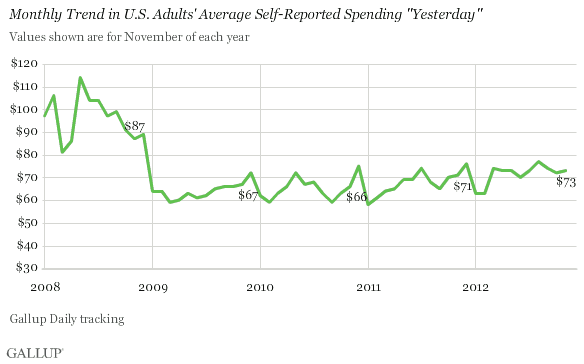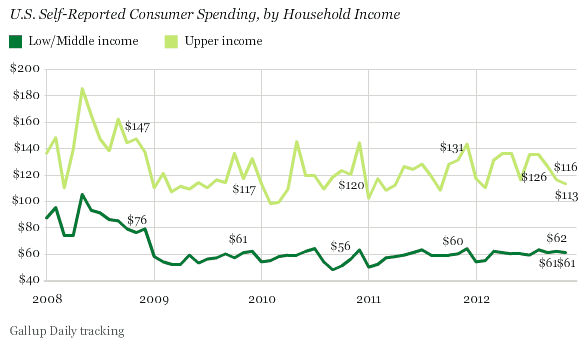WASHINGTON, D.C. -- Americans' self-reported daily spending averaged $73 in November, essentially on par with September and October. It is also similar to the $71 Americans spent last November and slightly higher compared with November 2010 and 2009 -- but still much lower than in November 2008.

Consumer spending had risen to near a four-year high in August ($77), but has since fallen off slightly.
The results are based on Gallup Daily tracking from Nov. 1-30. Each night, Gallup asks Americans to report how much they spent the prior day apart from normal household bills or the purchase of a car or home.
U.S. Upper-Income Spending Sees Worst November on Record
Upper-income Americans' (defined as those making at least $90,000 per year) self-reported daily spending was lower this November -- an average of $113 -- than in any November dating back to 2008. Upper-income spending has been trending downward since September, although the decline has not been large enough to drag down the overall spending figures.
Lower-income Americans' spending in November -- an average of $61 -- is on par with the $60 they spent last November. Lower-income spending is generally quite stable from month to month and has been holding steady since March.

Bottom Line
Although November marks the beginning of the holiday season -- generally a time for spending and splurging -- Americans did not spend any more than usual this November, and upper-income Americans appear to be spending less than usual. Americans' self-reported spending in November is on par with November 2011, matching Gallup's finding that Americans predict they will spend about as much on holiday gifts this year as they did last year.
However, spending did pick up in late November, around the time of Black Friday and in particular Cyber Monday, and has continued on a higher pace in Gallup Daily tracking in early December. Spending is also tracking higher compared with the same time last year. How long this upswing will continue and who exactly is spending more is unclear at this point. Upper-income spending typically increases sizably every December, so monitoring what this key group does this December will be an important sign of how the overall economy is faring.
Gallup.com reports results from these indexes in daily, weekly, and monthly averages and in Gallup.com stories. Complete trend data are always available to view and export in the following charts:
Daily: Employment, Economic Confidence, Job Creation, Consumer Spending
Weekly: Employment, Economic Confidence, Job Creation, Consumer Spending
Read more about Gallup's economic measures.
View our economic release schedule.
Survey Methods
Results are based on telephone interviews conducted as part of the Gallup Daily tracking survey Nov. 1-30, 2012, with a random sample of 14,187 adults, aged 18 and older, living in all 50 U.S. states and the District of Columbia, selected using random-digit-dial sampling.
For results based on the total sample of national adults, one can say with 95% confidence that the maximum margin of sampling error is ±1 percentage point.
The estimates for average daily spending have a margin of sampling error of ±$4.
Interviews are conducted with respondents on landline telephones and cellular phones, with interviews conducted in Spanish for respondents who are primarily Spanish-speaking. Each sample includes a minimum quota of 400 cellphone respondents and 600 landline respondents per 1,000 national adults, with additional minimum quotas among landline respondents by region. Landline telephone numbers are chosen at random among listed telephone numbers. Cellphone numbers are selected using random-digit-dial methods. Landline respondents are chosen at random within each household on the basis of which member had the most recent birthday.
Samples are weighted by gender, age, race, Hispanic ethnicity, education, region, adults in the household, and phone status (cellphone only/landline only/both, cellphone mostly, and having an unlisted landline number). Demographic weighting targets are based on the March 2011 Current Population Survey figures for the aged 18 and older non-institutionalized population living in U.S. telephone households. All reported margins of sampling error include the computed design effects for weighting and sample design.
In addition to sampling error, question wording and practical difficulties in conducting surveys can introduce error or bias into the findings of public opinion polls.
For more details on Gallup's polling methodology, visit https://www.gallup.com/.
